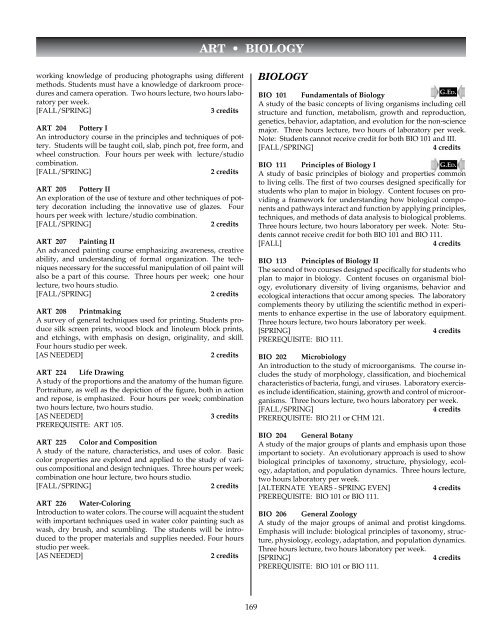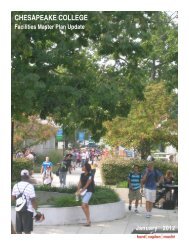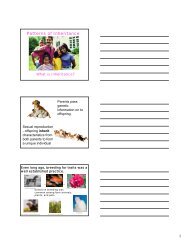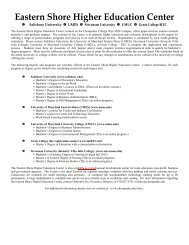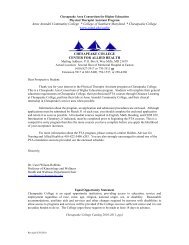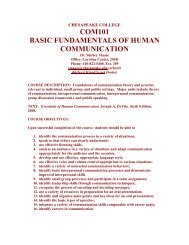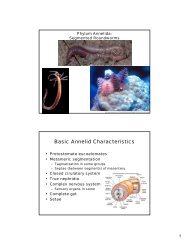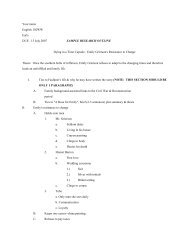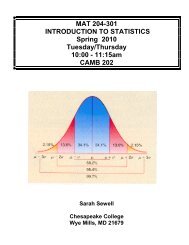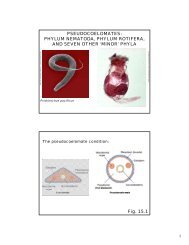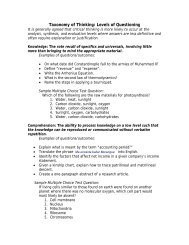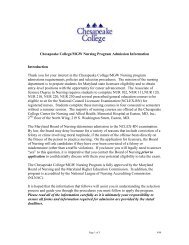arCHITECTUral TECHNOlOGy • arTmakng technques. One hour lecture, four hours laboratory perweek.[FALL]3 creditsPREREQUISITE: ACH 110.ACH 203 Specifications, Codes and EstimationThe study of buldng codes, restrctons, legal documents, specficationwriting, and estimating for bids for residential and commercalconstructon. Three hours lecture per week.[SPRING]3 creditsPREREQUISITE: ACH 100.ACH 204 Materials and Methods of Construction IIA study of the materals and methods used n commercal constructon.The course emphaszes commonly used structuralsystems, the use of buldng systems, and detalng of commercalconstructon. Two hours lecture, two hours laboratory perweek.[FALL]3 creditsPREREQUISITE: ACH 114.ACH 210 Architectural Drawing IVThe sequence and method of completng an archtectural desgnappled to a typcal medum-rse buldng. Course covers schematcdesgn, desgn development, and presentaton drawngs.Indvdual work on a personal portfolo s requred. One hourlecture, four hours laboratory per week.[SPRING]3 creditsPREREQUISITE: ACH 200.ACH 230 History of ArchitectureA course coverng the hstory of archtecture through lecture andslde presentatons. Students wll study the orgns and elementsof archtectural style. Archtectural chronology wll be studedfrom antquty to the 19th century. The mportance of shelter,communty dentty, relgon, government, terran, clmate, fash-on, aesthetcs and ndustry as ssues n the development andevoluton of archtectural practces wll be followed. Three lecturehours per week.[FALL]3 creditsACH 231 History of American ArchitectureA course coverng the hstory of Amercan archtecture throughlecture and slde presentatons. Students wll study the orgnsand elements of archtectural style n North Amerca. Leaders ofAmercan archtectural desgn wll be studed, along wth therpractces and prncples, desgn knowledge, ntegrty, and eth-cs. Students wll partcpate n a tour of the surroundng areato dscover the elements of Amercan archtectural style. Threelecture hours per week.[SPRING]3 creditsARTART 100 Design FundamentalsA studo course ntroducng the basc elements and prncplesof art ncludng percepton, vsualzaton, symbolzaton, andsketchng. Students apply prncples n a seres of projects. Twohours lecture, two hours laboratory per week.[AS NEEDED]3 creditsART 101 Introduction to Artg.ed.A study of the basc elements of vsual form and ther applcatonto the rchness and varety of art. Tradtonal and contemporaryexamples of significant architecture, design, two-dimensionalwork, and sculpture are examned n relaton to the prncples bywhch they may be apprecated. Three hours lecture per week.[FALL/SPRING]3 creditsART 105 Drawing FundamentalsAn exploraton of concepts and technques basc to representatonaldrawng. Projects chosen by the nstructor wll developsklls applcable to stll-lfe, landscapes, nterors, and the humanfigure. This course is open to students of all levels of experience.Four hours lecture/laboratory per week.[FALL]3 creditsART 106 Painting IAn ntroductory course desgned to acquant the student wthrepresentatonal means of expresson. The emphass s on basccomposton and the successful applcaton of ol pant. Threehours per week, one hour lecture and two hours studo.[FALL/SPRING]2 creditsART 107 Drawing: Style and TechniqueAn ndvdualzed course emphaszng the development of apersonal drawng style and technque. Ths course s open tostudents of all levels of experence. Four hours per week; combnatontwo hours lecture, two hours studo.[SPRING]3 creditsART 115 History of Art IA survey of art from prmtve tmes through the early Renassance.Monumental and resdental archtecture, pantng, andsculpture are studied through slides and films. Three hours lectureper week. [AS NEEDED]3 creditsART 116 History of Art IIA survey of art from the Renassance through the present day.Monumental and resdental archtecture, pantng, and sculptureare studied through slides and films. Three hours lecture perweek. [AS NEEDED]3 creditsART 160 Fundamentals of PhotographyAn ntroducton to techncal aspects of photography, ncludngcamera characteristics, photographic materials, film and printprocessng, and aesthetc consderatons such as topc selecton,lghtng, and composton. Darkroom technques are practced.Students are expected to furnsh ther own cameras. Two hourslecture, two hours laboratory per week.[FALL/SPRING]3 creditsART 161 Advanced PhotographyAn advanced course n photography n both color and blackand whte. Techncal aspects wll be dscussed n class followedby darkroom work n technques. Emphass wll be on ganng168
arT • BIOlOGyworkng knowledge of producng photographs usng dfferentmethods. Students must have a knowledge of darkroom proceduresand camera operaton. Two hours lecture, two hours laboratoryper week.[FALL/SPRING]3 creditsART 204 Pottery IAn ntroductory course n the prncples and technques of pottery.Students wll be taught col, slab, pnch pot, free form, andwheel constructon. Four hours per week wth lecture/studocombnaton.[FALL/SPRING]2 creditsART 205 Pottery IIAn exploraton of the use of texture and other technques of potterydecoraton ncludng the nnovatve use of glazes. Fourhours per week wth lecture/studo combnaton.[FALL/SPRING]2 creditsART 207 Painting IIAn advanced pantng course emphaszng awareness, creatveablty, and understandng of formal organzaton. The technquesnecessary for the successful manpulaton of ol pant wllalso be a part of ths course. Three hours per week; one hourlecture, two hours studo.[FALL/SPRING]2 creditsART 208 PrintmakingA survey of general technques used for prntng. Students produceslk screen prnts, wood block and lnoleum block prnts,and etchngs, wth emphass on desgn, orgnalty, and skll.Four hours studo per week.[AS NEEDED]2 creditsART 224 Life DrawingA study of the proportions and the anatomy of the human figure.Portraiture, as well as the depiction of the figure, both in actionand repose, s emphaszed. Four hours per week; combnatontwo hours lecture, two hours studo.[AS NEEDED]3 creditsPREREQUISITE: ART 105.ART 225 Color and CompositionA study of the nature, characterstcs, and uses of color. Basccolor propertes are explored and appled to the study of varouscompostonal and desgn technques. Three hours per week;combnaton one hour lecture, two hours studo.[FALL/SPRING]2 creditsART 226 Water-ColoringIntroducton to water colors. The course wll acquant the studentwth mportant technques used n water color pantng such aswash, dry brush, and scumblng. The students wll be ntroducedto the proper materals and supples needed. Four hoursstudo per week.[AS NEEDED]2 creditsBIOLOGYBIO 101 Fundamentals of Biologyg.ed.A study of the basc concepts of lvng organsms ncludng cellstructure and functon, metabolsm, growth and reproducton,genetcs, behavor, adaptaton, and evoluton for the non-scencemajor. Three hours lecture, two hours of laboratory per week.Note: Students cannot receve credt for both BIO 101 and III.[FALL/SPRING]4 creditsBIO 111 Principles of Biology Ig.ed.A study of basc prncples of bology and propertes commonto living cells. The first of two courses designed specifically forstudents who plan to major n bology. Content focuses on provdnga framework for understandng how bologcal componentsand pathways nteract and functon by applyng prncples,technques, and methods of data analyss to bologcal problems.Three hours lecture, two hours laboratory per week. Note: Studentscannot receve credt for both BIO 101 and BIO 111.[FALL]4 creditsBIO 113 Principles of Biology IIThe second of two courses designed specifically for students whoplan to major n bology. Content focuses on organsmal bology,evolutonary dversty of lvng organsms, behavor andecologcal nteractons that occur among speces. The laboratorycomplements theory by utilizing the scientific method in experimentsto enhance expertse n the use of laboratory equpment.Three hours lecture, two hours laboratory per week.[SPRING]4 creditsPREREQUISITE: BIO 111.BIO 202 MicrobiologyAn ntroducton to the study of mcroorgansms. The course ncludesthe study of morphology, classification, and biochemicalcharacterstcs of bactera, fung, and vruses. Laboratory exercsesinclude identification, staining, growth and control of microorgansms.Three hours lecture, two hours laboratory per week.[FALL/SPRING]4 creditsPREREQUISITE: BIO 211 or CHM 121.BIO 204 General BotanyA study of the major groups of plants and emphass upon thosemportant to socety. An evolutonary approach s used to showbologcal prncples of taxonomy, structure, physology, ecology,adaptaton, and populaton dynamcs. Three hours lecture,two hours laboratory per week.[ALTERNATE YEARS - SPRING EVEN]4 creditsPREREQUISITE: BIO 101 or BIO 111.BIO 206 General ZoologyA study of the major groups of anmal and protst kngdoms.Emphass wll nclude: bologcal prncples of taxonomy, structure,physology, ecology, adaptaton, and populaton dynamcs.Three hours lecture, two hours laboratory per week.[SPRING]4 creditsPREREQUISITE: BIO 101 or BIO 111.169
- Page 2 and 3:
Academic Calendar 2011-2012fall 201
- Page 4 and 5:
NOTICE TO STUDENTSWhle ths Catalog
- Page 6 and 7:
BOARD OF TRUSTEESCaroline CountyMar
- Page 8 and 9:
Directory of Telephone Service and
- Page 10:
Faculty DirectoryKamal P. Hennayake
- Page 14 and 15:
General InformationRegistration Off
- Page 16 and 17:
General inFormationHarassment Polic
- Page 18 and 19:
Admissions and Placement3. Students
- Page 20 and 21:
aDmissions anD PlacementD. Credit b
- Page 22 and 23:
aDmissions anD PlacementIf the stud
- Page 24 and 25:
Non-Traditional StudiesSpecial Stud
- Page 26 and 27:
Tuition and Fees, Expenses, Refunds
- Page 28 and 29:
tuition anD Fees, exPenses, reFunDs
- Page 30 and 31:
Student Financial assistanceFederal
- Page 32 and 33:
stuDent Financial assistanceSummer
- Page 34 and 35:
Student Financial AssistanceEndowed
- Page 36 and 37:
Student Financial AssistanceAward p
- Page 38 and 39:
Student Financial AssistanceOxford
- Page 40 and 41:
Student Financial AssistanceConditi
- Page 42 and 43:
stuDent Financial assistanceThe Fin
- Page 44 and 45:
Student Financial Assistance6. Subt
- Page 46 and 47:
Student Financial AssistanceThe Uni
- Page 48 and 49:
stuDent Financial assistanceCost of
- Page 50 and 51:
Student Records and PoliciesJohn T.
- Page 52 and 53:
Grading PoliciesGrading SystemGrade
- Page 54 and 55:
Student Services and PoliciesServic
- Page 56 and 57:
Student Services and PoliciesStuden
- Page 58 and 59:
stuDent services anD PoliciesU. Haz
- Page 60 and 61:
Dual Enrollment for High School Stu
- Page 62 and 63:
Gifted and Talented programChesapea
- Page 64 and 65:
Statewide ProgramsHuman Services*Al
- Page 66 and 67:
Opportunities for CompletionAssocia
- Page 68 and 69:
ProGrams oF stuDyTransfer ProgramsT
- Page 70 and 71:
General eDucation ProGramState Gene
- Page 72 and 73:
Areas of StudyProgram/Major Code Aw
- Page 74 and 75:
accountinG/BusinessThe College offe
- Page 76 and 77:
Accounting/BusinessACCOUNTINGADVANC
- Page 78 and 79:
accountinG/BusinessBUSINESS ADMINIS
- Page 80 and 81:
accountinG/BusinessBUSINESS MANAGEM
- Page 82 and 83:
comPuter stuDiesThe College offers
- Page 84 and 85:
comPuter stuDiesCOMPUTER INFORMATIO
- Page 86 and 87:
comPuter stuDiesINTERACTIVE MEDIA A
- Page 88 and 89:
comPuter stuDiesMICROCOMPUTER APPLI
- Page 90 and 91:
comPuter stuDiesCOMPUTER INFORMATIO
- Page 92 and 93:
comPuter stuDiesEDUCATIONAL TECHNOL
- Page 94 and 95:
criminal JusticeCORRECTIONSCERTIFIC
- Page 96 and 97:
criminal JusticeCRIMINAL JUSTICE DE
- Page 98 and 99:
criminal JusticeCRIMINAL JUSTICE DE
- Page 100 and 101:
criminal JusticeNATURAL RESOURCESCE
- Page 102 and 103:
eDucation/teacHinGEARLY CHILDHOOD D
- Page 104 and 105:
eDucation/teacHinGEARLY CHILDHOOD D
- Page 106 and 107:
eDucation/teacHinGELEMENTARY EDUCAT
- Page 108 and 109:
eDucation/teacHinGSECONDARY EDUCATI
- Page 110 and 111:
eDucation/teacHinGSECONDARY EDUCATI
- Page 112 and 113:
eDucation/teacHinGSECONDARY EDUCATI
- Page 114 and 115:
eDucation/teacHinGSECONDARY EDUCATI
- Page 116 and 117:
eDucation/teacHinGTEACHER AIDECERTI
- Page 118 and 119:
enGineerinG tecHnoloGyENGINEERING T
- Page 120 and 121:
enGineerinG tecHnoloGyWELDINGADVANC
- Page 122 and 123:
ENVIrONmENTal SCIENCEThe College of
- Page 124 and 125:
environmental scienceENVIRONMENTAL
- Page 126 and 127:
environmental scienceLAND USE MANAG
- Page 128 and 129:
HealtH ProFessionsNURSINGSCIENCE LA
- Page 130 and 131: HealtH ProFessionsEMERGENCY MEDICAL
- Page 132 and 133: HealtH ProFessionsEMERGENCY MEDICAL
- Page 134 and 135: HealtH ProFessionsGENERAL COLLEGE S
- Page 136 and 137: HealtH ProFessionsNURSING: REGISTER
- Page 138 and 139: HealtH ProFessionsPHLEBOTOMYLETTER
- Page 140 and 141: Health ProfessionsPHYSICAL THERAPIS
- Page 142 and 143: HealtH ProFessionsRADIOLOGIC SCIENC
- Page 144 and 145: HealtH ProFessionsSCIENCE LABORATOR
- Page 146 and 147: HealtH ProFessionsSURGICAL TECHNOLO
- Page 148 and 149: Hotel/restaurant manaGementHOTEL/RE
- Page 150 and 151: Hotel/restaurant manaGementHOTEL/RE
- Page 152: Human servicesHUMAN SERVICES DEGREE
- Page 155 and 156: liBeral arts anD sciencesLIBERAL AR
- Page 157 and 158: liBeral arts anD sciencesLIBERAL AR
- Page 159 and 160: liBeral arts anD sciencesLIBERAL AR
- Page 161 and 162: liBeral arts anD sciencesCOMMUNICAT
- Page 163 and 164: liBeral arts anD sciencesMusiC CoMp
- Page 165 and 166: liBeral arts anD sciencesLIBERAL AR
- Page 167 and 168: liBeral arts anD sciencesMATHEMATIC
- Page 169 and 170: liBeral arts anD sciencesTRANSFER S
- Page 171 and 172: ParaleGal ProFessionsThe College of
- Page 173 and 174: ParaleGal ProFessionsPARALEGAL STUD
- Page 175 and 176: tecHnical/ProFessional stuDiesTECHN
- Page 177 and 178: course DescriPtionsEfforts wll be m
- Page 179: allIED HEalTH • aNTHrOpOlOGy •
- Page 183 and 184: BUSINESS • CarDIaC rESCUE TECHNIC
- Page 185 and 186: CHEmISTry • COmmUNICaTION • COm
- Page 187 and 188: COmpUTEr INFOrmaTION SySTEmSfile sy
- Page 189 and 190: CrImINal JUSTICE • DEVElOpmENTal
- Page 191 and 192: Early CHIlDHOOD DEVElOpmENT • ECO
- Page 193 and 194: EDUCaTION • ElECTrONICS TECHNOlOG
- Page 195 and 196: EmErGENCy mEDICal TECHNICIaN • EN
- Page 197 and 198: ENGlISH • ESl • FIlm • FooD s
- Page 199 and 200: GeoGraPHy • HealtH eD • History
- Page 201 and 202: Humanities • interactive meDia &
- Page 203 and 204: matHematicsMAT 031 Elementary Algeb
- Page 205 and 206: mUSIC • NUrSINGMUS 166 Piano Clas
- Page 207 and 208: NUrSING • NUTrITION • paralEGal
- Page 209 and 210: pHySICal THErapIST aSSISTaNTPHYSICA
- Page 211 and 212: PsycHoloGy • raDioloGic sciencesP
- Page 213 and 214: aDioloGic sciences • scienceRSR 2
- Page 215 and 216: surGical tecHnoloGy • tecHnoloGy
- Page 217 and 218: DinG205
- Page 219 and 220: College Administration, Staff and F
- Page 221 and 222: College Administration, Staff and F
- Page 223 and 224: College Administration, Staff and F
- Page 225 and 226: College Administration, Staff and F
- Page 227 and 228: Curriculum Advisory CommitteesARTCa
- Page 229 and 230: AddendumAppendix 1.Student Transfer
- Page 231 and 232:
Addendumcollege is definable as a p
- Page 233 and 234:
Addendumability of courses at 4-yea
- Page 235 and 236:
Addendumshall be encouraged to comp
- Page 237 and 238:
AddendumE. Sending Institution: The
- Page 239 and 240:
IndexAAbility to Benefit, Student F
- Page 241 and 242:
IndexComputer Information Systems,
- Page 243 and 244:
IndexEnrollment Status, Conditions
- Page 245 and 246:
IndexLetter of Recognition, Graduat
- Page 247 and 248:
IndexSSatisfactory Academic Progres
- Page 249:
DIRECTIONS FROM ANNAPOLIS AND POINT


